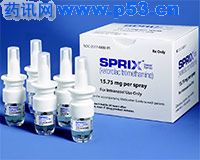| 2010年5月17日,位于美国加州Menlo Park 的Roxro制药公司今天宣布,美国食品药品监督管理局(FDA)已批准酮咯酸氨丁三醇(ketorolac tromethamine)的鼻内制剂(Sprix喷鼻剂)用于需要阿片类镇痛药进行控制的中度至中重度疼痛的短期治疗。
该制剂在非住院患者中可用于治疗达到5天。该公司称,酮咯酸是一种非甾体抗炎药(NSAID),在医院内常被作为一种肌内(IM)注射剂用于中重度疼痛的短期治疗。而这次批准的新制剂可通过鼻内给予,并通过鼻粘膜吸收,可与肌内注射剂同样快地达到峰浓度。伊利诺斯州芝加哥市的Rush大学医学中心矫形外科麻醉学部主任Askomur Buvanendran表示,该新产品“可满足用于急救疼痛控制的新的非类阿片、非注射的需要,因为该药在提供有效控制中度至中重度疼痛的同时,还可使发生滥用以及与麻醉性止痛剂相关的副作用的可能性降至最低。这种方便使用的喷鼻剂还能提供院外的疼痛治疗。” 该公司在声明中提到,这种新制剂已在伴有中度至中重度疼痛的患者中进行过单独给药和与吗啡联用的研究。该药的申请材料中包括来自14项共纳入超过1000名受试者的临床试验,以及4项成人对照性、有效性研究,在这些研究中均满足主要的研究终点。2项分别纳入超过300名进行选择性腹部或矫形外科手术患者的3期试验显示,与安慰剂组患者相比,使用Sprix后48h内疼痛强度的总评分显著降低,且差异有统计学意义。另外,接受了酮咯酸鼻内制剂的患者还显示与安慰剂组相比,其48h内吗啡的用量减少了26%~36%。 另外,同其他酮咯酸制剂一样,使用这种鼻内制剂的总持续时间应尽可地缩短,不超过5天。其他风险和禁忌症如下: 1、酮咯酸可引起消化性溃疡、胃肠道出血和/或致命性胃或肠穿孔。鼻内用酮咯酸禁用于伴有消化性溃疡病或胃肠道出血史的患者; 2、鼻内用酮咯酸可抑制血小板功能,故应禁用于伴有疑似或确诊的脑血管出血、出血素质、未完全止血或出血风险较高的患者; 3、NSAID可能引起致命性严重心血管事件、心肌梗塞和中风的风险增加,该新闻发布稿提到。这种风险可能会随着用药持续时间的延长而增加,并且在伴有心血管病或心血管风险因素的患者中较高。这种酮咯酸鼻内制剂禁用于冠状动脉旁路移植血管(CABG)手术的围手术期疼痛的治疗。 4、鼻内用酮咯酸禁用于伴有晚期肾损害和具有因体液消耗而导致肾衰竭风险的患者;另外,该产品禁用于已知对阿司匹林、酮咯酸或其他NSAID、EDTA过敏或有过敏反应史的患者,以及既往曾进行过大手术的患者或分娩期间。不应与丙磺舒或己酮可可碱同时使用。 轻度、短暂性鼻部不适是该鼻内制剂最常见的不良反应。Roxro药业公司的首席执行官(CEO)Roberto Rosenkranz在该公司的声明中表示,“现已批准的酮咯酸的注射剂型已被医生们很好地接受用于院内治疗,因此我们相信,这种更为方便的剂型将会很快被使用。” Sprix(ketorolac tromethamine,酮洛酸氨丁三醇)鼻腔喷雾剂 Manufacturer:Luitpold Pharmaceuticals Pharmacological Class:NSAID (pyrrolo-pyrrole). Active Ingredient(s):Ketorolac tromethamine 15.75mg; per 100microliter nasal spray; contains EDTA. Indication(s):For the short-term (up to 5 days) management of moderate to moderately severe pain that requires analgesia at the opioid level. Pharmacology:Sprix contains ketorolac tromethamine, a nonsteroidal anti-inflammatory drug (NSAID). Ketorolac is an analgesic that inhibits the enzyme cyclooxygenase (COX), an early component of the arachidonic acid cascade, resulting in the reduced synthesis of prostaglandins, thromboxanes, and prostacyclin. Clinical Trials:The effect of Sprix on acute pain was evaluated in two multicenter, randomized, double-blind, placebo-controlled studies. In a study of adults who had undergone elective abdominal or orthopedic surgery, 300 patients were randomized and treated with Sprix or placebo administered every 8 hours and morphine administered via patient controlled analgesia on an as needed basis. Efficacy was demonstrated as a statistically significant greater reduction in the summed pain intensity difference over 48 hours in patients who received Sprix as compared to those receiving placebo. The clinical relevance of this is reflected in the finding that patients treated with Sprix required 36% less morphine over 48 hours than patients treated with placebo. In a study of adults who had undergone elective abdominal surgery, 321 patients were randomized and treated with Sprix or placebo administered every 6 hours and morphine administered via patient controlled analgesia on an as needed basis. Efficacy was demonstrated as a statistically significant greater reduction in the summed pain intensity difference over 48 hours in patients who received Sprix as compared to those receiving placebo. The clinical relevance of this is reflected in the finding that patients treated with Sprix required 26% less morphine over 48 hours than patients treated with placebo. Legal Classification:Rx Adults:≥18yrs: 1 spray in each nostril (total dose: 31.5mg) every 6–8hrs; max daily dose 126mg (4 doses). ≥65yrs, renally-impaired, or <50kg: 1 spray in one nostril (total dose: 15.75mg) every 6–8hrs; max daily dose 63mg (4 doses). Discard used bottle after 24hrs. Children:<18yrs: not recommended. Contraindication(s):Active peptic ulcer, recent GI bleed or perforation, history of peptic ulcer or GI bleeding. Cerebrovascular bleeding, hemorrhagic diathesis, incomplete hemostasis, or for whom hemostasis is critical. History of asthma, urticaria, aspirin allergy. Pre-op use. CABG surgery. Advanced renal disease or at risk for renal failure due to volume depletion. EDTA allergy. Concomitant probenecid, pentoxifylline. Labor & delivery. Nursing mothers. Warnings/Precautions:Increased risk of GI, bleeding, cardiovascular, or renal effects. Inflammatory bowel disease (eg, ulcerative colitis, Crohn’s disease). Hypertension. CHF. Edema. Coagulation disorders. Post-op use. Maintain adequate hydration. Impaired heart, renal, or liver function. Avoid spraying into eyes. Debilitated. Elderly. Pregnancy (Cat.C prior to 30 weeks gestation; Cat.D starting at 30 weeks gestation). Interaction(s):See Contraindications. Do not use concomitantly with other formulations of ketorolac or other NSAIDs. Increased risk of bleeding with concomitant anticoagulants, SSRIs. May diminish effects of furosemide, thiazides, ACE inhibitors, angiotensin II receptor antagonists. Possible seizures with phenytoin, carbamazepine. Possible hallucinations with fluoxetine, thiothixene, alprazolam. Monitor for lithium, methotrexate toxicity. Caution with nondepolarizing muscle relaxants (apnea). Adverse Reaction(s):Nasal discomfort, rhinalgia, increased lacrimation, throat irritation, oliguria, rash, bradycardia, decreased urine output, increased ALT/AST, hypertension, rhinitis; GI bleed/ulceration/perforation (discontinue if occurs), anaphylactoid reactions, serious skin reactions (eg, exfoliative dermatitis, Stevens-Johnson syndrome, toxic epidermal necrolysis; may be fatal), severe hepatic reactions (eg, jaundice, fulminant hepatitis, liver necrosis, hepatic failure; discontinue if develops), severe renal effects (eg, renal papillary necrosis, interstitial nephritis, nephrotic syndrome; with long-term use). See literature re: risk of cardiovascular events. How Supplied:Single-day nasal spray bottle (8 sprays/1.7g bottle)—1, 5 Last Updated:6/16/2011 |
Sprix(ketorolac tromethamine,酮洛酸氨丁三醇)鼻腔喷雾剂简介:
2010年5月17日,位于美国加州Menlo Park 的Roxro制药公司今天宣布,美国食品药品监督管理局(FDA)已批准酮咯酸氨丁三醇(ketorolac tromethamine)的鼻内制剂(Sprix喷鼻剂)用于需要阿片类镇痛药进行控 ... 责任编辑:admin |
最新文章更多推荐文章更多热点文章更多 |


